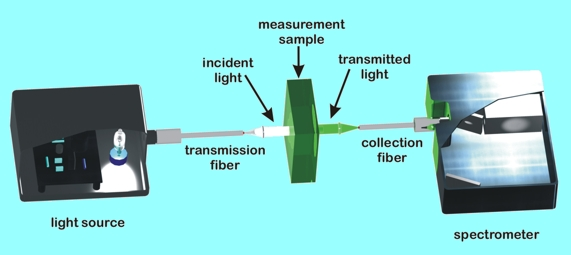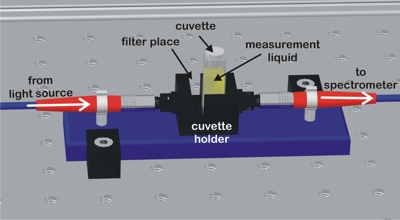The typical basic optical measurements for the characterization of solids and liquids are absorbance, transmittance, reflectance and fluorescence.
All these measurements are performed with the same procedure the steps of which are:
- The broadband light emitted from the light source is guided to sample under analysis, through the transmission optical fiber
- The interaction of the emitted light with the sample under characterization, that performs transformation of the original light spectrum,
- The acquisition of the transformed spectrum by the spectrometer, through the collection fiber system and
- The processing of the acquired light through through appropriate algorithms.

Due to the non linearity of the light source's intensity, and the spectrometer's detector background noise and spectral response, two more spectra are required for the optical measurements: i) the Reference and ii) the Dark Spectra.
With FR-tools, both reflectance and transmittance measurements are performed:
Absorbance/Transmittance measurements
The Absorbance/Transmittance spectra show the Absorbed/Transmitted light through the sample under investigation vs. wavelength.
The sample under investigation can be either solid or liquid. Figure 1 shows a generic Absorbance/Transmittance holder for liquid samples mounted on the working area of a FR-tool. For more detailed description on how to perform the absorbance measurement please refer to section on FR-Monitor manual, in Download section.
The definition of absorbance (A(λ)) is:
A(λ)=-log10(Is/Io)
where:
Io is the reference light intensity, typically the emission light, e.g. with empty cuvette and
Is is the light intensity through sample of interest.
For precise measurements the dark spectrum should be subtracted from both sample and reference spectra, so eq. 1a becomes:
A(λ)=-log10((Isam-Idark)/(Iref-Idark))
where:
Iref is the reference light intensity, i.e. the light intensity of the light source used, as it is recorded by the spectrometer without passing through the sample of interest, e.g. with empty cuvette for liquid sample.
Isam is the light intensity after passing through the sample i.e. the light intensity recorded by the spectrometer when the light from the light source passes through the sample of interest.
Idark is the dark intensity i.e. the light intensity recorded by the spectrometer with the light source switched-off or blocked and without sample.
Usually the absorbance value is in the [0, 2] range reflecting the [0-99]% absorbance range.
On the other hand, the definition of transmittance (T(λ)) is:
T(λ)=Is/Io *100%
and by taking into account the dark spectrum as in the absorbance case:
T(λ)=(Is/Io *100%
